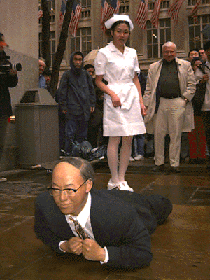BUSINESS AS UN-USUAL
by
Ranier Ganahl
January, 1997
New York, New York

In Japanese, Miyata-san is what in English is called a "salary man," a "kaishain," or what translates best as a businessman, or employee. He is perfectly dressed in a business suit and performs between high rises in business centers. What differentiates the Miyata-san from any other businessman in this world is that he is made to look so uniform. He just crawls on the floor. Just crawls he doesnít do or know anything else but crawling since he is a life-size, crawling robot designed by the Japanese artist Momomyo Torimitsu, who assists him dressed as a nurse.The artist from Tokyo applied for PS 1, as she says, in order to have Miyata-san not just crawling in Shinshuku and Ghinza but also on Wall Street and at Rockefeller Center. Lucky and successful like the business world, this high-tech puppet represents the artist, and her "salary man" was accepted in New York exceptionally well. Without any particular institutional help she just sent a press release Torimitsu had Miyata-san crawl in the streets of Manhattan, generating lots of interest. But it wasnít just the curiosity of passers-by that was attracted to the spectacular performance of this hyper-real Japanese businessman in New Yorkís streets where virtually nobody draws any attention. In particular, the mass media took notice, as well. Among others, Fortune magazine one of Americaís leading business magazines as well as TV stations ran reports. The power and success of this life-sized crawling doll lies in the dramatic representation of a businessman in its most humiliating position: crawling in the street in a suit. This is a strong linguistic metaphor as well as a psychoanalytical and a pathological one.
Torimitsuís short press release also spoke of Miyata-san as one of an "army of salarymen" which corresponds easily to western semi-chauvinistic business reports on Japanese economic affairs. Independent of its national and economic aspects in a global capital context the performance of Asian economic power is known by now there remains the emblem of degradation and humiliation that switches so easily between the representation of somebody else and the self-identification with this humiliated figure on the floor since we all realate to crawling as an exhausting activity that nobody really escapes. The danger of representation as far as one thinks oneself independent of the world of business people lies in the arrogance with which one looks down upon this life-generating realm of our world that too, is undergoing critical transformation as a result of economic changes and technological innovations. Computerized networking home offices are already undressing many employees, allowing them to sit on the couch at home in front of a workstation where the crawling continues, even more cruelly, on the puffy carpet.
The fact that a major business magazine is picking up on this "salary man" speaks for itself. But this magazine, too, doesnít escape the double structure of this figure: representation and identification, that which makes the robot intriguing and utterly human. As an art work its is important to see that it already has an existence outside its confined limits that most art working with the pathetic lacks. Momoyo Torimitsu comes out of a Japanese tradition of young artists who very easily use spectacular machines, robots and mass media icons. They surprise the western art scene with sophisticated materials, high-tech applications, unusual, often hyper-realistic object designs made in one of the most advanced technological and semiotic landscapes. Though there tradition is completely western-oriented, Japanese artists still do also have some kind of access to other symbolic and semiotic traditions that produce amalgams which cannot be reduced or analyzed with the very problematic dichotomies like Western or Eastern, modern or traditional. One also needs to stay away from analytical sketches on Japanese symbolic productions offered by Roland Barthes or Jean Baudrillard who stress the simulacrum and speak of an "empire of signs" deprived of any substance. These concepts are, in the end, not much more then troubled, Eurocentric and, ultimately, racially biased projections by visitors who canít handle a sophisticated culture and technology outside the Western belt. Nonetheless, there remains the question reinvigorated by the work of Momoyo Torimitsuís Miyata-san, namely, to which degree does art have to compete with the spectacular content of media which the artist has achieved successfully well. They love her and her objects. Maybe the art world soon too.
Rainer Ganahl
Email: ThingReviews
To post a response fill out the following form and click the "Submit" button. Or go back...
Scroll down to read messages.
Keiko -- soma@bway.net
Responds:
Torimitsu's strength lies in her clear and congruous placement of her work in the right context. In Japan where the concept of fine art never existed as an autonomous realm independent of everyday life (including working places), such clarity may be easier to attain than here, where the business sect is often perceived as an antithesis to art. Miyata IS a representation of Japanese salary-men and identified by salary-men, and he drew the anticipated attention from the business world. Everything about him is relevant, just like a good soldier/businessman in an army. Irony is not found nor to be demanded. If she (or her fans) wants the same type of enthusiastic response from the New York art world, she must apply the content/context structure relevant to this environment with the same clarity and relevance. But I don't know if that's relevant to her personal interest. In any case, I will be there again as the curious bystander.
--
Responds:
